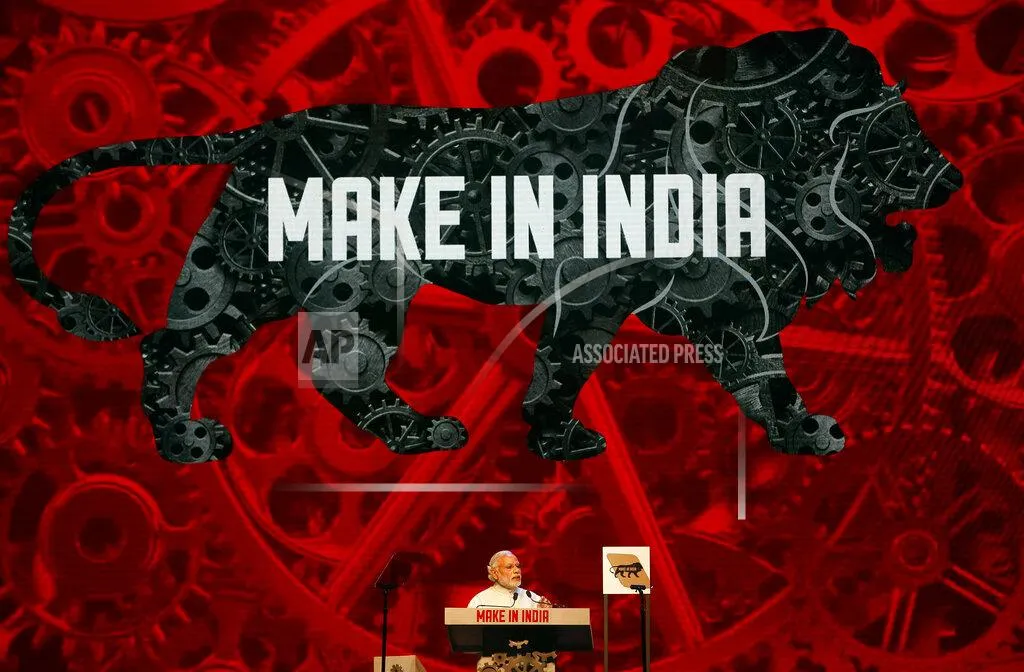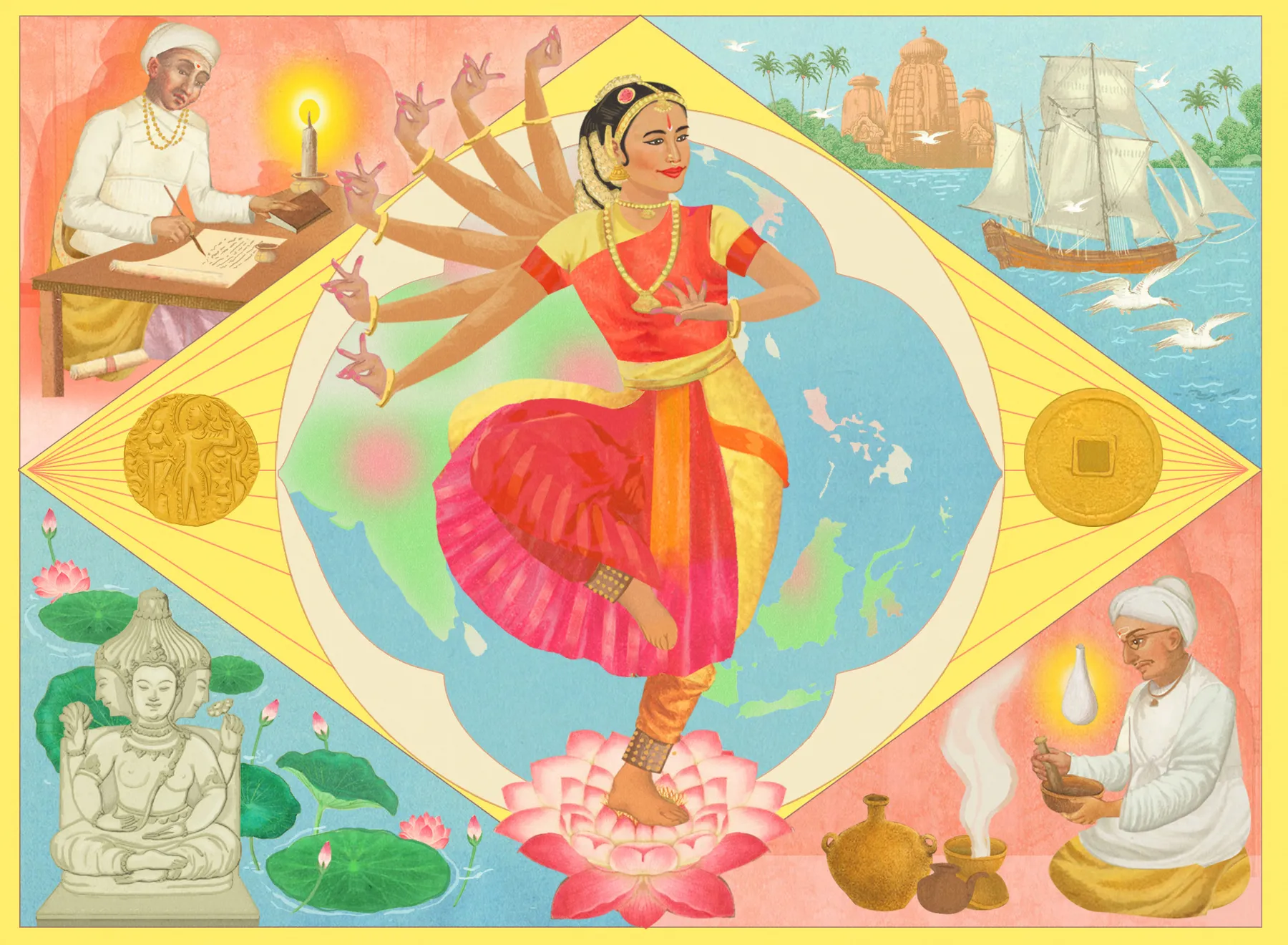India’s trade routes and intra-Asian ties flourished long before Europeans arrived, William Dalrymple outlines in The Golden Road.
If the 19th century was defined by European power, and the 20th century by the rise of the US, the 21st century is increasingly understood to be the “Asian Century” — one in which the global enter of gravity is shifting yet again. And if you accept that assertion, the next logical question is: Who will lead the Asian Century? The two natural candidates are the region’s historical powers, China and India, which were the world’s largest economies from 1 A.D. to 1820, before the rise of the industrial west. They are once again among the planet’s preeminent economies.
By most measures, China is currently outperforming India. Its $18.5 trillion GDP is more than four times larger than India’s, and it accounted for $6.64 trillion in global trade in 2023 — 11% of the global share, to India’s 2.7% ($1.64 trillion). Its military is mightier, and it has greater influence in international affairs. In 2013, China launched the Belt and Road Initiative, an attempt to revive the ancient web of trade routes, known as the Silk Road, that connected the Middle Kingdom to all parts west.
But in his masterful new work, The Golden Road (Bloomsbury, April 29), historian William Dalrymple argues that India has both the potential and the historical track record to catch up with its former peer to the northeast. Citing compelling evidence, Dalrymple notes that many of the great advances in human history originated from Indian civilization, particularly in mathematics (including the concept of zero), religion (Hinduism and Buddhism) and philosophy, astronomy, medicine, literature and art. He argues that the world overlooked India’s vast influence, and that trade routes emanating from India may have had an equally substantive impact on Asian and world history as the Chinese silk route.
India was “a crucial economic fulcrum, and civilizational engine, at the heart of the ancient and early medieval worlds,” Dalrymple writes, describing the country as “one of the main motors of global trade and cultural transmission.”
The Golden Road fills an important gap in our understanding of the intra-Asian relations that predated the arrival of European colonizers. While one modern conceit is that globalization is a recent development, the book demonstrates how much of Asia was for centuries connected through a common lingua franca, Sanskrit. Ideas of Hindu-Buddhist kingship and cosmology were prevalent throughout these regions; Buddhism also took root in Japan, Korea and Southeast Asia. In the Middle East, Indian ideas in mathematics and medicine led to further advances during the Islamic Golden Age. From the Arab world, these Indic concepts were transmitted to Europe, where they also helped spur the European Renaissance.
Dalrymple suggests the world overlooked India’s influence because it was “undermined, misrepresented and devalued” by Victorian Indologists such as Thomas Babington Macaulay. In 1835 Macaulay wrote that it would be “no exaggeration to say that all the historical information which has been collected from all the books written in the Sanskrit language is less valuable than what may be found in the most paltry abridgments used at preparatory schools in England.”
But that was then. To compete with Beijing now, New Delhi needs to develop economic muscle, though it can also draw a great deal of competitive soft power from the history of its “Golden Road,” the ancient routes that connected India to the rest of Asia and the wider world. Dalrymple outlines three ways for India to leverage its history to enhance its competitive position vis-à-vis China and stake its claim to leadership of the Asian Century.
The first is to rediscover the great virtues of openness to international trade. While India’s current economy may in relative terms be more closed than that of China, Dalrymple shows that India’s trade with the rest of the world matched, if not exceeded, that of China for millennia. This resulted in prosperity at home, which in turn enabled Indian culture to shine.
“In the crucial period between the end of antiquity and the onset of the high Middle Ages, you can make [a] case for India being the cultural and intellectual center of Asia, influencing and changing the course of religious, artistic and cultural life,” Dalrymple writes. “This after all was why [Chinese scholars] risked their lives to make the dangerous journey to what was then the Harvard or MIT of ancient Asia: the great Buddhist university of Nalanda.”
Many Indians believe that the country’s large domestic market means it doesn’t need international trade to grow faster. While few officials state this view out loud, the Indian government’s actions indicate an underlying belief in continued reliance on domestic consumption for economic growth, encouraging companies to focus on the Indian market rather than exports. India backed out of the Regional Comprehensive Economic Partnership in 2019, for fear of Chinese goods flooding the domestic market. It is in no hurry to enter into free-trade agreements with Western countries — despite long-standing negotiations with the UK and the European Union — apparently because it wants to protect sensitive sectors like agriculture, which employs close to half of the working population.
This is short-sighted. If China is leveraging the $100 trillion global economy to grow while India relies on its $4 trillion domestic market, India will remain at a disadvantage. Arvind Subramanian, former chief economic advisor to the Indian government, argued in a recent interview with the Financial Times, “You cannot do [it] based on domestic demand and a domestic market.”
As for fears of being swamped by imports from China, a study by the Peterson Institute for International Economics shows that India’s economy would in fact gain $60 billion annually from more openness. It also makes economic sense to encourage foreign investment, particularly in the manufacturing sector. In theory, New Delhi’s ‘Make in India’ initiative — which encourages manufacturing in the country — is meant to do just this. In practice, it has been slow in encouraging investment.
The second takeaway for India’s current rulers from their country’s history is the importance of India’s traditional links with Northeast Asia. The most successful and dynamic economies of Asia are now found in that region, with Japan, South Korea and China outperforming the rest of the continent. As Dalrymple notes, a significant part of the DNA of their civilizations comes from India.
These days, there are deep suspicions between China and India, just as there are between China, Japan and South Korea. Geopolitical differences explain these suspicions, but their shared cultural history might help overcome them. While Dalrymple’s book pits India’s Golden Road against the China-dominated Silk Road, the way forward for both countries may well be a concomitant and cooperative revival of both ancient routes, repurposed for economic and scientific cooperation through the Global South.
China has launched its Health Silk Road initiative — through which it aims to improve international cooperation in health care — and India has been providing pharmaceuticals and medical equipment to the developing world at low or no cost, simultaneously sharing its expertise. At the height of the Covid-19 pandemic, when the West was reluctant to share vaccines with the Global South, China and India stepped up and filled the gap. There is great opportunity for them to continue to collaborate in enhancing health-care access, especially in the poorer countries of the Global South.

The third, and arguably best, opportunity for leverage in India lies in Southeast Asia, the region most influenced by Indian civilization, as Dalrymple documents in great detail. One of the curious anomalies in history is that even though Southeast Asia is geographically closer to China, nine of its 10 countries have an Indic cultural base, most obviously expressed in religious and cultural practices. Only Vietnam has a Sinic base.
That cultural base was built on economic ties. In the 4th and 5th centuries, when western supplies of gold dwindled due to the fall of the Roman Empire, Indian traders turned to Southeast Asia. Their ships sailed to what would eventually become Myanmar, Malaysia, Indonesia, Thailand, Laos, Vietnam and Cambodia. The traders also exported their faith, seeding Hindu and Buddhist kingdoms across the region. Few Indians today know that one of the strongest Hindu kingdoms in history emerged in Southeast Asia.
Although Hinduism is now a minority faith in the region, its cultural influence lingers: The Hindu epics Ramayana and Mahabharata are still performed in many corners of Southeast Asia. Buddhism is the largest of the major world religions in six of the region’s 10 countries. Given these ties, there should be a close cultural relationship between India and Southeast Asia matching the cultural closeness between Europe and the US. But no such closeness exists.
One reason is that India became part of the ‘Persianate World’ during the second millennium (as the historian Richard Eaton demonstrates in his writings) and turned away from Southeast Asia. Another reason is present-day India’s relative economic and political insularity, particularly in comparison to China.
If India is to provide leadership in the Asian Century, the most natural starting place would be Southeast Asia. And the first step would be to restore the close trading links of old. This would require catching up with China, no easy task. As of 2023, the most recent year for which definitive figures are available, Southeast Asia’s goods trade with China was $697 billion, almost seven times larger than that of India. But as recently as 1980, Indian goods trade with Southeast Asia was $1.3 billion, only half that of China’s.
India is expected to become the third largest economy in the world by 2030. Given that it was one of the poorest countries in the world upon achieving independence in 1947, this would be a remarkable achievement. But to create opportunities for its enormous population, it needs to do more. In that respect, Dalrymple’s book couldn’t be more timely. The Golden Road is not only a reminder of a glorious past; it can also inspire Indians to match the sterling record of their ancestors in engaging a new rejuvenated continent — and claim the leadership of the Asian Century.



